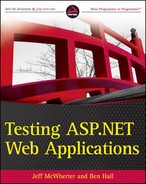1.8. Introducing the ASP.NET Family
When ASP.NET was released in 2002, there was not much of a "family" to speak of. During the past six years, many new components have been developed under the ASP.NET product umbrella and warrant a brief discussion. Throughout this book, we will apply the testing topics and tools for each type of testing discussed in this book — many of the products in the ASP.NET family.
ASP.NET WebForms. When people think of ASP.NET, developers think of WebForms. WebForms consist of an ASPX file, designer file, and a code-behind file. The majority of ASP.NET applications are built using this technology. In fact, WebForms is the View Rendering template engine which lives on top of the core ASP.NET runtime built using WebForms.
ASP.NET MVC. The ASP.NET MVC Framework is an implementation of the Model View Controller (MVC) architectural pattern that isolates business logic, data logic, and user interface logic. In the past, Microsoft developers have thought of this type of architecture as layers, but MVC is more about components than layers.
Silverlight. In 2007, Microsoft released Silverlight, which is a cross-platform/browser, multimedia browser platform for developing Rich Internet Applications (RIA). The user interface is created using the XAML markup language similar to Windows Presentation Foundation (WPF).
ASP.NET Web Services. ASP.NET Web Services are components installed on a web server that allow applications to make HTTP requests to the component and receive data back in a standard format such as XML or SOAP.
ASP.NET AJAX Framework. Included with Visual Studio 2008 by default, and Visual Studio 2005 as a standalone extension, Microsoft has provided ASP developers with an AJAX framework to aid in asynchronous JavaScript calls.
ADO.NET Data Services. Code named Astoria, ADO.NET Data Services is a framework of patterns and libraries that enable creation and consumption of ADO data in the cloud (the Internet). ADO.NET data services interfaces to data with well-known formats such as JSON and XML.
In 1997, soon after Internet Information Systems 4 (IIS) shipped, Mark Anders and Scott Guthrie began work on the predecessor of ASP 3.0, what many developers now call "classic ASP." One of the main goals of this new project is to address separation of concern much better than the previous version of ASP. Through a few name changes (XSP and ASP+), what we now call ASP.NET 1.0 WebForms was released to the world on January 5, 2002.
